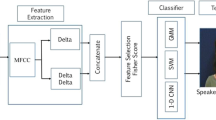Abstract
With continuously growing maturity, speaker verification applications using sensed voices from the person to verify his identify and validness have increased in daily life. Nevertheless, the recognition performance of all speaker verification systems yet built is undeniably inferior to that of a human listener. Therefore, how to improve effectively the recognition performance of speaker verification applications has been challenging. In the field of speaker verification, the Gaussian mixture model (GMM) and support vector machines (SVMs) are two widely-used techniques. This paper thoroughly investigates the exploitation of a GMM-SVM dual modeling framework for speaker verification, specifically regarding the low false acceptance rate for recognition systems. Within the framework of GMM-SVMs, this study proposes two effective approaches to combine GMM and SVM classifiers, the parallel-GMMSVM and the serial-GMMSVM. Experimental results show that both of the developed methods can enhance the conventional verification scheme and effectively improve recognition performance.





Similar content being viewed by others
References
Burges CJC (1998) A tutorial on support vector machines for pattern recognition. Data Min Knowl Disc 2(2):121–167
Ding I-J, Yen C-T, Lin Z-J (2013) Fuzzy logic-based intelligent control for SVM speaker verification with the support of GMM prior information. Trans Can Soc Mech Eng 37(3):467–476
Kenny P, Boulianne G, Ouellet P, Dumouchel P (2007) Speaker and session variability in GMM-based speaker verification. IEEE Trans Audio Speech Lang Process 15(4):1448–1460
McLaren M, Vogt R, Baker B, Sridharan S (2010) Data-driven background dataset selection for SVM-based speaker verification. IEEE Trans Audio Speech Lang Process 18(6):1496–1506
Parhami B (1994) Voting algorithms. IEEE Trans Reliab 43(4):617–629
Reynolds DA, Rose RC (1995) Robust text-independent speaker identification using Gaussian mixture speaker models. IEEE Trans Speech Audio Process 3(1):72–83
Wang J-C, Yang C-H, Wang J-F, Lee H-P (2007) Robust speaker identification and verification. IEEE Comput Intell Mag 2(2):52–59
You CH, Lee KA, Li H (2009) An SVM kernel with GMM-supervector based on the Bhattacharyya distance for speaker recognition. IEEE Signal Process Lett 16(1):49–52
You CH, Lee KA, Li H (2010) GMM-SVM kernel with a Bhattacharyya-based distance for speaker recognition. IEEE Trans Audio Speech Lang Process 18(6):1300–1312
Author information
Authors and Affiliations
Corresponding author
Rights and permissions
About this article
Cite this article
Ding, IJ., Lin, ZJ. Identity authentication by sensed acoustic voices from a speaking person using an efficient GMM-SVM dual modeling framework. Microsyst Technol 24, 3–8 (2018). https://doi.org/10.1007/s00542-016-3100-3
Received:
Accepted:
Published:
Issue Date:
DOI: https://doi.org/10.1007/s00542-016-3100-3




